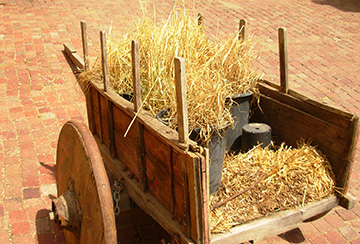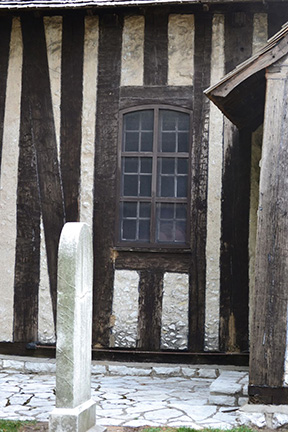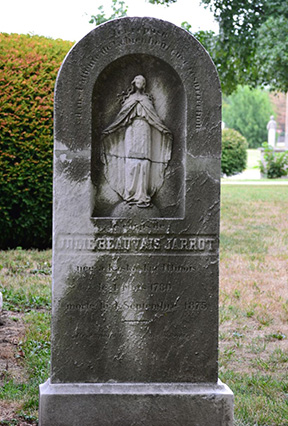
Old-style carts had wooden wheels, and wicker basketry enclosed the carrying area.
Slave-owning persisted past 1818 among French farmers in Illinois, including Etienne Pensoneau
A year after Illinois became a state that outlawed slavery, possibly the last slave sale took place when Etienne Pensoneau bought the slave Amy on June 4, 1819, from William Savage. The slave trade had been illegal since Illinois became part of the Northwest Territory in 1787, but exceptions were made for French landowners in the southern counties.
They were allowed to gradually convert the status of slaves into indentured servants who would eventually become free. The Indiana Territory law for indentured servitude, adopted in 1809 in Illinois, required a slave owner to appear in court along with the slave to make the change. Slaves could object to becoming indentured servants during the court appearance, but anyone who did not agree could be removed from the territory within sixty days.
Records note that the slave Amy had been indentured, meaning she would eventually be free, for time limits required women to be freed by the age of thirty-two, and men by thirty-five.
Etienne owned at least eight slaves—men, women, and children—during his years in Cahokia. The slave Matthieu, who worked at Etienne’s gristmill along Richland Creek, was sold by Etienne’s heirs, along with the mill and fifty acres of land, several years after he died in 1820. Matthieu had been indentured in 1813, and probably became free over time.
Etienne is noted in several histories for attacking a minister from the East who was speaking against slavery at a gathering near Richland Creek. John Reynolds, former Illinois governor, wrote in his memoir that townspeople thought this was an amusing incident about the “hasty and irritable” Frenchman who had a poor grasp of English, and that they enjoyed retelling the story for years.
Though slavery was common among the French landowners, or habitants, it was rare for anyone to own more than one or two slaves at a time, according to historian Cark Ekberg. He writes that 41 percent of landowners in Illinois towns had slaves, and the Jesuit priests of the Séminaire de Quebec owned the largest number. French farms were not run on the plantation system, and the owners worked in the fields along with slaves, servants, and laborers hired for the season. He also notes that the 1820 census for Illinois lists 917 slaves in the state, mainly in the southern counties with French population. The number of free black people, listed as "colored" at the time, was growing, as well.
Sales noted in county records
Ginga (or Ganga) a 50-year old male, sold by Louis Peltier to Etienne Pinsonneau, June 25, 1802, for $400 payable in deerskins reckoned at 2 ½ pounds per dollar.
Angelique, age 30, sold by Jean Dumolin, to Etienne Pinsonneau July 21, 1804; no listed price. Holy Family Church records show she died Oct. 30, 1808.
Frankey, sold by Etienne Pinsonneau to Samuel Gillham Aug. 12, 1815. Frankey “was a slave and my property before and at the time she indentured herself,” on Nov. 9, 1811. For $500 “I do hereby assign over all my right and the title to a child of said Frankey, a girl of about one year old.” Test. John Hay, Etne. Pensoneau. On Oct. 8, 1816, Gillham sold Frankey and her daughter to David Nix, Test. Col. Whiteside.
Mathew, indentured Dec. 27, 1813, was sold with Etienne’s gristmill and 50 acres, to Tannehill for $433, by Etienne’s heirs.
Amy, sold April 6, 1819 by William Savage to Etienne June 4, 1819; she had been indentured.
Deaths noted in Holy Family Church records
A Negro man aged about 50, drowned July 13, 1813, and a Negro boy aged about 5, died Feb. 5, 1813; his private baptism is noted.
French sea captain brought the first slaves in 1720
Philippe Francis Renault, a sea captain, imported dozens of slaves in 1720 to work in mines along the Mississippi River where he hoped to find silver. But when the mines produced only lead, the French king withdrew his financing for the effort, and Renault sailed away. He left the slaves behind, and the Jesuit mission in Cahokia took them on.
The people enslaved had come from the same river basin in Africa, were brought in over a dozen years, and lived for generations in a fairly isolated French community. Very few slaves were brought in after 1747, and those were from New Orleans. This allowed the slaves to keep their Bambara culture intact as they married and had families. As their descendants became free, they often moved to New Orleans and significantly influenced the black culture there. By the 1830s, the community of free blacks and people of mixed race, called les Gens de Couleur Libres, numbered in the thousands in the city.
France governed slavery in its colonies through the Code Noir. The code for Louisienne, dating from 1724, listed fifty-five points, including that slaves were fully human beings who deserved religious instruction and humane basic treatment. With the emergence of a powerful Abolitionist movement in France in the 1750s, slaves gained increasing rights, including being able to sue their owners and pursue routes to obtain freedom.
There is some evidence that slave owners in Cahokia followed the Code, for records for slaves at Holy Family Church note the christenings for slaves buried in the church’s cemetery. And by the 1830s, more than 300 “freedom cases” were brought in the Circuit Court in St. Louis by former slaves against prominent slave owners in St. Louis and Cahokia. The charges often involved false imprisonment or perpetuating servitude past the end of a term.

The cemetery at Holy Family Church had a section for burial of slaves. (Photo by Val Dale)

